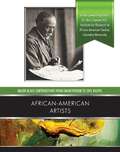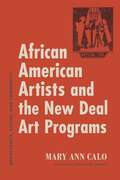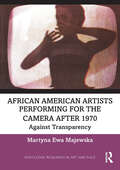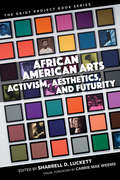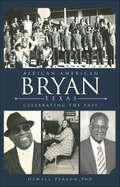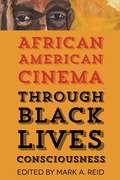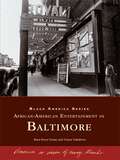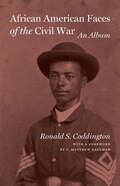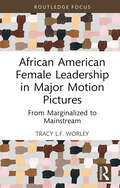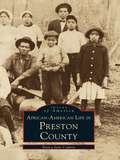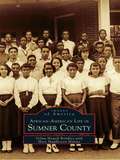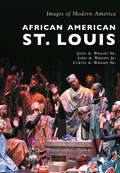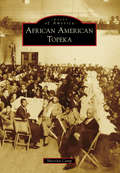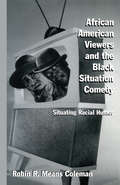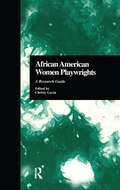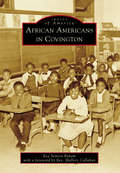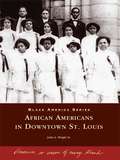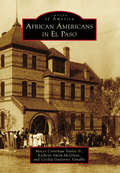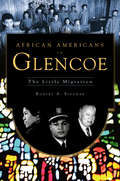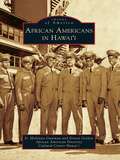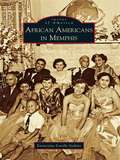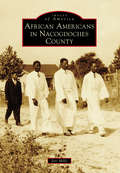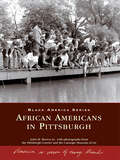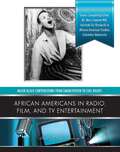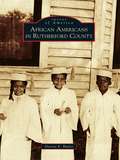- Table View
- List View
African American Artists (Major Black Contributions from Emancipat)
by Carol EllisFrom quilts to marble, from comic strips to welded steel, African Americans have created exciting works of art for more than a hundred years. African-American Artists traces the struggles and shows the work of many of these men and women. This book will introduce you to Harriet Powers, who was born a slave and who told legends and stories on her quilts. You'll meet Horace Pippin, who taught himself to paint and kept painting even after he lost the use of his arm. Cartoonist Aaron McGruder and digital artist Angela Perkins are among the African-American artists who continue to enrich the nation's culture today.
African American Artists and the New Deal Art Programs: Opportunity, Access, and Community
by Mary Ann CaloThis book examines the involvement of African American artists in the New Deal art programs of the 1930s. Emphasizing broader issues informed by the uniqueness of Black experience rather than individual artists’ works, Mary Ann Calo makes the case that the revolutionary vision of these federal art projects is best understood in the context of access to opportunity, mediated by the reality of racial segregation.Focusing primarily on the Federal Art Project (FAP) of the Works Progress Administration (WPA), Calo documents African American artists’ participation in community art centers in Harlem, in St. Louis, and throughout the South. She examines the internal workings of the Harlem Artists’ Guild, the Guild’s activities during the 1930s, and its alliances with other groups, such as the Artists’ Union and the National Negro Congress. Calo also explores African American artists’ representation in the exhibitions sponsored by WPA administrators and the critical reception of their work. In doing so, she elucidates the evolving meanings of the terms race, culture, and community in the interwar era. The book concludes with an essay by Jacqueline Francis on Black artists in the early 1940s, after the end of the FAP program.Presenting essential new archival information and important insights into the experiences of Black New Deal artists, this study expands the factual record and positions the cumulative evidence within the landscape of critical race studies. It will be welcomed by art historians and American studies scholars specializing in early twentieth-century race relations.
African American Artists Performing for the Camera After 1970: Against Transparency (Routledge Research in Art and Race)
by Martyna Ewa MajewskaThis study demonstrates how African American artists active since the 1970s have instrumentalized performance for the camera to intervene in existing representations of Black and Brown people in America and beyond.Majewska argues that producing carefully designed photographs, films, and videos via performance became a key strategy for dismantling the conceptions of race and gender fixed by US popular culture, jurisprudence, and pseudoscience. Studying the work of Adrian Piper, Glenn Ligon, Lyle Ashton Harris, Senga Nengudi, Maren Hassinger, Howardena Pindell, David Hammons, and Pope.L, this book examines the ways in which these artists incorporate their bodies and personal experience into their respective performances, simultaneously courting and foreclosing autobiographical readings. The strategies examined here, while diverse, all challenge conventional interpretations of performance art—especially those overdetermined by race, gender, and sexuality.The book will be of interest to scholars working in art history, performance studies, photography, and African American studies.
African American Arts: Activism, Aesthetics, and Futurity (The Griot Project Book Series)
by Sharrell D. Luckett Carmen Gillespie Rikki Byrd Amber Lauren Johnson Doria E. Charlson Florencia V. Cornet Daniel McNeil Lucy Caplan Genevieve Hyacinthe Sammantha McCalla Nettrice R. Gaskins Abby Dobson J. Michael Kinsey Shondrika Moss-Bouldin Julie B. Johnson Jasmine Eileen Coles Tawnya Pettiford-Wates Rickerby HindsSignaling such recent activist and aesthetic concepts in the work of Kara Walker, Childish Gambino, BLM, Janelle Monáe, and Kendrick Lamar, and marking the exit of the Obama Administration and the opening of the National Museum of African American History and Culture, this anthology explores the role of African American arts in shaping the future, and further informing new directions we might take in honoring and protecting the success of African Americans in the U.S. The essays in African American Arts: Activism, Aesthetics, and Futurity engage readers in critical conversations by activists, scholars, and artists reflecting on national and transnational legacies of African American activism as an element of artistic practice, particularly as they concern artistic expression and race relations, and the intersections of creative processes with economic, sociological, and psychological inequalities. Scholars from the fields of communication, theater, queer studies, media studies, performance studies, dance, visual arts, and fashion design, to name a few, collectively ask: What are the connections between African American arts, the work of social justice, and creative processes? If we conceive the arts as critical to the legacy of Black activism in the United States, how can we use that construct to inform our understanding of the complicated intersections of African American activism and aesthetics? How might we as scholars and creative thinkers further employ the arts to envision and shape a verdant society? Contributors: Carrie Mae Weems, Carmen Gillespie, Rikki Byrd, Amber Lauren Johnson, Doria E. Charlson, Florencia V. Cornet, Daniel McNeil, Lucy Caplan, Genevieve Hyacinthe, Sammantha McCalla, Nettrice R. Gaskins, Abby Dobson, J. Michael Kinsey, Shondrika Moss-Bouldin, Julie B. Johnson, Sharrell D. Luckett, Jasmine Eileen Coles, Tawnya Pettiford-Wates, Rickerby Hinds. Published by Bucknell University Press. Distributed worldwide by Rutgers University Press.
African American Bryan, Texas: Celebrating the Past (American Heritage)
by Oswell Person PhDBryan was incorporated in 1872, but it would take more than ten years before its African American population was offered schooling. Nothing would come easy for them, but they persevered through hard work, ingenuity and family support. The success of today's generation is a direct result of determined, hardworking pioneers like Dr. Samuel J. Sealey Sr., Bryan's "baby doctor" in the 1930s and '40s, and Dr. William A. Hammond Sr., who opened Bryan's first black hospital and employed many blacks through his business ventures. Learn about the inspiration and guidance provided by the likes of Oliver Wayne Sadberry, an outstanding community leader and principal of Fairview and Washington Elementary. Dr. Oswell Person shares the story of this community's achievements, successes and contributions in the face of incredible odds.
African American Cinema through Black Lives Consciousness
by Dr Melba Joyce Boyd Dr Jonathan Munby Gerald R. Butters Jr. Charlene Regester African American Cinema James Smalls African American Cinema Anne Cremieux African American Cinema Chesya Burke African American Cinema Kimberly Nichele Brown African American Cinema Patricia Hilliard-Nunn African American Cinema Mark D Cunningham African American Cinema Dan Flory Karen Bowdre Mark A. ReidAfrican American Cinema through Black Lives Consciousness uses critical race theory to discuss American films that embrace contemporary issues of race, sexuality, class, and gender. Its linear history chronicles black-oriented narrative film from post–World War II through the presidential administration of Barack Obama. Editor Mark A. Reid has assembled a stellar list of contributors who approach their film analyses as an intersectional practice that combines queer theory, feminism/womanism, and class analytical strategies alongside conventional film history and theory. Taken together, the essays invigorate a "Black Lives Consciousness," which speaks to the value of black bodies that might be traumatized and those bodies that are coming into being-ness through intersectional theoretical analysis and everyday activism. The volume includes essays such as Gerald R. Butters’s, "Blaxploitation Film," which charts the genre and its uses of violence, sex, and misogyny to provoke a realization of other philosophical and sociopolitical themes that concern intersectional praxis. Dan Flory’s "African-American Film Noir" explains the intertextual—fictional and socio-ecological—dynamics of black action films. Melba J. Boyd’s essay, "‘Who’s that Nigga on that Nag?’: Django Unchained and the Return of the Blaxploitation Hero," argues that the film provides cultural and historical insight, "signifies" on blackface stereotypes, and chastises Hollywood cinema’s misrepresentation of slavery. African American Cinema through Black Lives Consciousness embraces varied social experiences within a cinematic Black Lives Consciousness intersectionality. The interdisciplinary quality of the anthology makes it approachable to students and scholars of fields ranging from film to culture to African American studies alike.
African-American Entertainment in Baltimore (Black America Series)
by Tonya Taliaferro Rosa Pryor-TrustyAfrican-American Entertainment in Baltimore captures the brilliance of the city's musical heritage from 1930 to 1980. This educational and entertaining volume invites readers to take a visual trip down memory lane to the days when Pennsylvania Avenue, the heart of the city's African-American community, vibrated with life. Celebrated within these pages are entertainers such as The Ink Spots, Sonny Til & the Orioles, Illinois Jacquet, Cab Calloway, Lionel Hampton, Sammy Davis Jr., Slappy White, Pearl Bailey, Billie Holiday, and Ella Fitzgerald; The Avenue's hottest nightspots and theaters including the legendary Royal Theater, The Regent Theater, the Sphinx, and Club Casino; and the DJs and promoters who helped cultivate the city's musical talents.
African American Faces of the Civil War: An Album
by Ronald S. CoddingtonDiscover the men of color who fought for their freedom during the Civil War through profiles illustrated with original wartime photographs.A renowned collector of Civil War photographs and a prodigious researcher, Ronald S. Coddington combines compelling archival images with biographical stories that reveal the human side of the war. This third volume in his series on Civil War soldiers contains previously unpublished photographs of African American Civil War participants—many of whom fought to secure their freedom. During the Civil War, 200,000 African American men enlisted in the Union army or navy. Some of them were free men and some escaped from slavery; others were released by sympathetic owners to serve the war effort. African American Faces of the Civil War tells the story of the Civil War through the images of men of color who served in roles that ranged from servants and laborers to enlisted men and junior officers.Coddington discovers these portraits—cartes de visite, ambrotypes, and tintypes—in museums, archives, and private collections. He has pieced together each individual’s life and fate based upon personal documents, military records, and pension files. These stories tell of ordinary men who became fighters, of the prejudice they faced, and of the challenges they endured. African American Faces of the Civil War makes an important contribution to a comparatively understudied aspect of the war and provides a fascinating look into lives that helped shape America.
African American Female Leadership in Major Motion Pictures: From Marginalized to Mainstream (Routledge Studies in Media Theory and Practice)
by Tracy L.F. WorleyThis book explores the factors contributing to the under-representation of African American female directors in mainstream cinema leadership. It also unmasks the potential strategies African American female film directors might pursue to reduce this inequity.Author Tracy L. F. Worley draws on research around ethics to conclude that there are specific consequences of the male gaze on women in cinema leadership, especially African American female directors of box office cinema. Combining extensive analysis of ethics and ethical stance relative to the motion picture industry with perspectives from working African American female directors, the text discusses the ethical considerations and historical inequities, including the male gaze, and uses those findings to define how the inequities can be opportunities. The efficacy model for cinematic leadership is presented as a mechanism for viewing obstacles through the lenses of gender, ethnicity, and culture so they become drivers for African American women to achieve success.Ideal for students of directing and filmmaking, as well as aspiring professional filmmakers wishing to gain a better understanding of the industry as it stands today.
African-American Life in Preston County (Images of America)
by Nancy Jane CopneyPreston County, an area nestled in the northern corner of West Virginia, is bounded on the north byPennsylvania and the Mason-Dixon line and on the eastby the state of Maryland. This scenic Appalachian region is primarily a farming community, though mining, timber, recreation, and tourism have also been vital contributors to the county's economy. The small yet vibrant African-American community of Preston County, whose story is told here through family photographs, documents, and memories, is a vital part of the county's heritage. For generations, these families have worked on the land and in the mines; they have raised their children and built their homes in Preston County. Vintage images from as early as the 1860s preserve theAfrican-American story of the mothers and fathers andthe mine workers and farmers who have played andcontinue to play an important role in the history of this beautiful part of the world.
African-American Life in Sumner County
by Mary Huddleston Malone Velma Howell BrinkleyEarly African Americans in Sumner County, both slaves and free, left a legacy not only of beautiful brick buildings and sturdy stone fences, but also a social history as rich and varied as the many tribes they represented. This exciting book is an invaluable resource for anyone interested in the immeasurable contributions, undeniable services, and the devotion of black Americans to the evolution of Sumner County's communities. Many of the sienna-hued photographs and Civil War-era tintypes presented here were taken when folks wore their Sunday best and didn't smile for the camera. These images, many never before published, capture everything from a "creek baptism" and bonnet worn by a local slave, to views of families and schoolchildren. The volume covers most of the early settlements in Sumner County where African Americans largely resided, fromRockland and Avondale to Scattersville, Parker's Chapel, and Gallatin.
African American St. Louis: Disappearing Black Communities (Images of Modern America)
by John A. Wright Sr. Curtis A. Wright Sr. John A. Wright Jr.The city of St. Louis is known for its African American citizens and their many contributions to the culture within its borders, the country, and the world. Images of Modern America: African American St. Louis profiles some of the events that helped shape St. Louis from the 1960s to the present. Tracing key milestones in the city's history, this book attempts to pay homage to those African Americans who sacrificed to advance fair socioeconomic conditions for all. In the closing decades of the Great Migration north, the civil rights movement was taking place nationally; simultaneously, St. Louis's African Americans were organizing to exert political power for greater control over their destiny. Protests, voter registration, and elections to public office opened new doors to the city's African Americans. It resulted in the movement for fairness in hiring practices and the expansion of the African American presence in sports, education, and entertainment.
African American Topeka (Images of America)
by Sherrita CampAfrican Americans arrived in Topeka right before and after the Civil War and again in large numbers during the Exodus Movement of 1879 and Great Migration of 1910. They came in protest of the treatment they received in the South. The history of dissent lived on in Topeka, as it became the home to court cases protesting discrimination of all kinds. African Americans came to the city determined that education would provide them a better life. Black educators fostered a sense of duty toward schooling, and in 1954 Topeka became a landmark for African Americans across the country with the Brown vs. Topeka Board of Education case. Blacks from every walk of life found refuge in Kansas and, especially, Topeka. The images in African American Topeka have been selected to give the reader a glimpse into the heritage of black life in the community. The richness of the culture and values of this Midwestern city are a little-known secret just waiting to be exhibited.
African American Viewers and the Black Situation Comedy: Situating Racial Humor (Studies in African American History and Culture)
by Robin R. Means ColemanProviding new insight into key debates over race and representation in the media, this ethnographic study explores the ways in which African Americans have been depicted in Black situation comedies-from 1950's Beulah to contemporary series like Martin and Living Single.
African American Women Playwrights: A Research Guide (Critical Studies in Black Life and Culture #31)
by Christy GavinFirst Published in 1999. Routledge is an imprint of Taylor & Francis, an informa company.
African Americans in Covington (Images of America)
by Rev Mallery Callahan Eva Semien BahamCovington is the seat of St. Tammany Parish government and sits north of Lake Pontchartrain in the New Orleans metropolitan area. Records from 1727 show 11 Africans on the north shore. One person of African descent was present at the founding of Covington on July 4, 1813. Most African Americans in antebellum Covington were slaves, with a modest number of free people, all of whom covered nearly every occupation needed for the development and sustenance of a heavily forested region. For more than 200 years in Covington, African Americans transformed their second-class status by grounding themselves in shared religious and social values. They organized churches, schools, civic organizations, benevolent societies, athletic associations, and businesses to address their needs and to celebrate their joys.
African Americans in Downtown St. Louis (Black America Series)
by John A. Wright Sr.Since the founding of St. Louis in 1764, Downtown St. Louis has been a center of black cultural, economic, political, and legal achievements that have shaped not only the city of St. Louis, but the nation as well. From James Beckworth, one of the founders of Denver, Colorado, to Elizabeth Keckley, Mary Todd Lincoln's seamstress and author of the only behind-the-scenes account of Lincoln's White House years, black residents of Downtown St. Louis have made an indelible mark in American history. From the monumental Dred Scott case to entertainers such as Josephine Baker, Downtown St. Louis has been home to many unforgettable faces, places, and events that have shaped and strengthened the American experience for all.
African Americans in El Paso (Images of America)
by Kathryn Smith-Mcglynn Maceo Crenshaw Dailey Jr. Cecilia Gutierrez VenableEl Paso's African American community can trace its origins back to the 16th century, when the black Moor known as Esteban roamed the southwest and, more significantly, those Africans in the party of conquistador Juan de Oñate crossed the Rio Grande in 1598. The modern El Paso African American community began to take shape in the 1880s, as the railroad industry, military establishment, and agricultural community all had black Americans in their ranks. Black leaders and their followers established a school and founded several significant black churches. Texas's first state branch of the National Association for the Advancement of Colored People is recorded to have been formed in El Paso; the first major court cases that challenged the all-white Democratic primary came from this city; the Texas Western College basketball team won the NCAA championship in 1966 with five starting black players; and today, the city is inhabited by black military retirees, entrepreneurs, educators, and other professionals (each with vibrant and socially conscious organizations), making it a progressive model of community development.
African Americans in Glencoe: The Little Migration (American Heritage)
by Robert A. SidemanThe village of Glencoe has a proud history of early African American settlement. In recent years, however, this once thriving African American community has begunto disperse. Robert Sideman, a thirty-year Glencoe resident, relates this North Shore suburb's African American history through fond remembrances of Glencoe communitiessuch as the St. Paul AME Church, as well as recounting the lives of prominent African Americans. At the same time, Sideman poses a difficult question: how can the village maintainits diverse heritage throughout changing times? African Americans in Glencoe reveals an uplifting history while challenging residents to embrace a past in danger of being lost.
African Americans in Hawai'i (Images of America)
by D. Molentia Guttman African American Diversity Cultural Center Hawai'i Ernest GoldenDuring the early 1800s, about two dozen men of African descent lived in Hawai'i. The most noteworthy was Anthony D. Allen, a businessman who had traveled around the world before making Hawai'i his home and starting a family there in 1810. The 25th Black Infantry Regiment, also known as the Buffalo Soldiers, arrived in Honolulu at the Schofield Barracks in 1913. They built an 18-mile trail to the summit of Mauna Loa, the world's largest shield volcano, and constructed a cabin there for research scientists. After World War II, the black population of Hawai'i increased dramatically as military families moved permanently to the island. Hawai'i has a diverse population, and today about 35,000 residents, approximately three percent, claim African ancestry.
African Americans in Memphis (Images of America)
by Earnestine Lovelle JenkinsMemphis has been an important city for African Americans in the South since the Civil War. They migrated from within Tennessee and from surrounding states to the urban crossroads in large numbers after emancipation, seeking freedom from the oppressive race relations of the rural South. Images of America: African Americans in Memphis chronicles this regional experience from the 19th century to the 1950s. Historic black Memphians were railroad men, bricklayers, chauffeurs, dressmakers, headwaiters, and beauticians, as well as businessmen, teachers, principals, barbers, preachers, musicians, nurses, doctors, Republican leaders, and Pullman car porters. During the Jim Crow era, they established social, political, economic, and educational institutions that sustained their communities in one of the most rigidly segregated cities in America. The dynamic growth and change of the post-World War II South set the stage for a new, authentic, black urban culture defined by Memphis gospel, blues, and rhythm and blues music; black radio; black newspapers; and religious pageants.
African Americans in Nacogdoches County (Images of America)
by Jeri MillsTypical of most communities after the Civil War, Nacogdoches's African Americans had to repurpose their lives by building their own communities while they carved a life of survival first and progress second. The images in this book will tell the stories of the first churches and how they became the center of the community. Other images will share information about the early leaders in the community who helped establish educational facilities for "Negroes." Additional images focus on black businesses, and a final set of images will discuss the emerging black middle class and others who played significant roles in Nacogdoches history. Readers of this book will go on a journey, through images, that highlights residents' pains of struggles and gains of triumph.
African Americans in Pittsburgh (Black America Series)
by Carnegie Museum of Art Pittsburgh Courier John M. Brewer Jr.African Americans in Pittsburgh chronicles the distinct trends in this African American community. There was never one centralized neighborhood where a majority of the black population lived, and city schools were integrated until after desegregation laws were passed. Photographs captured by famed Pittsburgh photographer Charles "Teenie" Harris show the candid experiences of residents, including the achievements and celebrations of people struggling to put scraps of food on the table.
African Americans in Radio, Film, and TV Entertainers (Major Black Contributions from Emancipat)
by Linda J. ArmstrongThis book is filled with fascinating stories, from the night a shy young woman's play changed Broadway to the day the most successful talk show host in history got her start. Find out about the stage actor who once earned letters in four college sports--and who won academic honors, too. Follow the triumphs and disappointments of some of the most famous black entertainers in our nation's history. Rediscover great personalities who have been forgotten. And learn about how the roles of black performers both changed with and helped changed American society.
African Americans in Rutherford County (Images of America)
by Devora E. ButlerAfrican Americans have heavily contributed to and shaped the unique and vibrant Rutherford County in middle Tennessee. Located 30 miles southeast of Nashville, Rutherford County is at the state's geographical center. This area is home to the Stones River National Battlefield, a national park that was the site of a major Civil War battle--the Battle of Stones River. Tourists come from all over the world to experience this rich cultural and historic venue that once served, although briefly, as the capital of Tennessee. African American men and women have lived, worked, and toiled here for generations.
